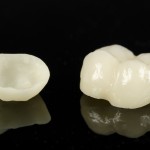
There are two material choices for restoration of dental implants. The first is metal-ceramic which has proved to have high survival rates and low complication rates. Ceramic, on the other hand, is a relatively newer alternative material for restoration of implants. Use of ceramic prostheses allows for superior aesthetics, less gingival discolouration and lower bacterial adhesion compared to metal-ceramics. Both materials have some limitations; metal-ceramic restorations are less aesthetics and may be more costly and time consuming, whilst ceramic restorations may be less resistant to fracture. To date, there are no systematic reviews in favour of one material over the other.
This systematic review tries to demonstrate the null hypothesis that there is no difference between ceramic and metal-ceramic restorations with regards to prosthesis survival rate, marginal bone loss and biological and mechanical complication rates.
Methods
Searches were conducted with two independent reviewers of three databases, PubMed/Medline, Web of Science and Cochrane, using PRISMA guidelines and indexed up to 31st March 2018. Manual searches were also completed in several journals and non-peer reviewed literature, and searches were not limited to the English language. Randomised control trials, prospective studies and direct comparison studies with at least 1-year follow-up were used. Case studies and series were excluded. The quality of studies was assessed via the Cochrane Risk of Bias tool for RCTs and Newcastle-Ottawa for prospective studies.
Meta-analysis was completed, Mechanical and biological complication rates and prosthesis survival rates were the dichotomous outcomes evaluated using the risk ratio (RR). Marginal bone loss was considered a continuous outcome and evaluated using mean difference (MD) values. A sub analysis was performed for mechanical complications in terms of the type of prosthesis (single crowns and FPDs). Sub analyses for the other analyses could not be performed because of the absence of data of included studies on FPDs.
Results
- 7 RCTs and 5 Prospective studies were included, giving 428 participants with a mean age of 40.9 years.
- All prospective studies were considered low-risk of bias, however of the 7 RCTs, one included was at low risk of bias, and one is high risk of bias. In the remaining 5 the risk of bias was unclear.
- Within the included studies, existed results that tended to favour both ceramic and metalo-ceramic restorations against each of the three outcome measures.
- For mechanical complications, the summary statistic did not identify a difference between ceramic an metalo-ceramic restorations with a mechanical complications risk ratio (RR) = 0.95 (95%CI; 0.45, 1.98).
- For biological complications, the summary statistic did not identify a difference between ceramic an metalo-ceramic restorations with a biological complications risk ratio (RR) = 48 (95%CI; 0.80, 2.73)
- For prostheses survival rate, the summary statistic did not identify a difference between ceramic an metalo-ceramic restorations with a survival rate risk ratio (RR) =40 (95%CI; 0.45, 4.41)
Conclusions
Within the limitations of the study, the authors concluded that
Ceramic implant-supported prostheses have similar mechanical and biological complication rates, prosthesis survival rates, and marginal bone loss as metal-ceramic restorations and that both treatments are viable for long-term restoration.
Comments
- The author has searched a good number of popular databases and has made attempts to search for non-published studies and those in other languages therefore overall a good attempt was made to find all the relevant studies.
- All studies were recent, and information was given on the scores of each paper on the Newcastle -Ottawa or the Cochrane Risk of Bias tool, allowing the reader to draw their own conclusions on the quality of the papers included.
- Prospective studies – were these Cohort studies? The author could have potentially just used the RCT’s – did they need these prospective studies?
- Some of the confidence intervals were large, and in some cases not overlapping between papers, leading the team to question if their definitions of each outcome were sufficiently similar to allow combination of results. A higher population base would increase the validity of results.
- It is interesting to compare the findings of this review with another recent review (Dental Elf – 8th March 2019) which focused on all ceramic crowns including a broader range of study designs which also suggest similar survival rates between ceramic and metal -ceramic crowns.
Links
Primary paper
Lemos CAA, Verri FR, Gomes JML, de Souza Batista VE, Cruz RS, Oliveira HFFE, Pellizzer EP. Ceramic versus metal-ceramic implant-supported prostheses: A systematic review and meta-analysis. J Prosthet Dent. 2019 Jan 17. pii:S0022-3913(18)30856-4. doi: 10.1016/j.prosdent.2018.09.016. [Epub ahead of print] Review. PubMed PMID: 30661882.
Original review protocol on PROSPERO
Other References
Scarano A, Piattelli M, Caputi S, Favero GA, Piattelli A. Bacterial adhesion on commercially pure titanium and zirconium oxide disks: an in vivo human study. J Periodontol 2004;75:292-6.
Sailer I, Philipp A, Zembic A, Pjetursson BE, Hammerle CH, Zwahlen M. A systematic review of the performance of ceramic and metal implant abutments supporting fixed implant reconstructions. Clin Oral Implants Res 2009;20:4-31.
Heintze SD, Rousson V. Survival of zirconia- and metal-supported fixed dental prostheses: a systematic review. Int J Prosthodont 2010;23:493-502.
Hobkirk JA, Wiskott HW. Ceramics in implant dentistry (Working Group 1). Clin Oral Implants Res 2009;20:55-7.
Tinschert J, Zwez D, Marx R, Anusavice KJ. Structural reliability of alumina-, feldspar-, leucite-, mica- and zirconia-based ceramics. J Dent 2000;28:529-35.
Dental Elf – 8th March 2019
Acknowledgments
This blog was developed by MSc Students from @UClanDentistry during a workshop with the @TheDentalElf

Written by MSc Students Sophie Walters, Cipra Sharma, Vanesha Patel, Sofia Orfanidou, Ryan Hughes Nadim Majid @UClanDentistry
